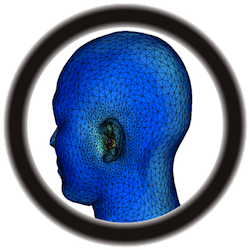- General remarks
- Recent publications
- Finite element method
- Boundary element method
- Shape and topology optimization
- Applications
General remarks
Computer simulations are widely used in the design and development processes of devices, machineries, structures, etc., to predict their performance and physical behaviors. Since more and more complicated computation models and accurate simulations are demanded, development of advanced computation techniques for more complicated physical phenomena and fast computation algorithms for large degrees of freedoms are getting important. Our research themes are concerned with development of advanced numerical methods and their applications to designs of sophisticated devices and structures using the developed numerical methods. The finite element method and boundary element method are mainly faces on as the computational approaches. The boundary element method requires only the boundary meshing. The drawbacks that existed intrinsically in the BEM has been resolved as the consequence of the emergence of fast computation algorithms based on the multipole expansion of the fundamental solution. Therefore, not only the finite element method but also the boundary element method is now one of the strong simulation tools in the computer-aided engineering, particularly in shape and topology optimization problems that require re-meshing through optimization processes.
The followings are some of the topics we are currently coping with.
- Development of advanced numerical methods in computational mechanics
- Fast multipole boundary element method for design sensitivity analysis of three-dimensional acoustic field
- Development of fast and large scale computation algorithms for boundary element method using GPU
- Thermoelastic damping analysis of micro-scale piezoelectric materials using multiple precision eigenvalue analysis
- Finite element analysis of photonic random laser
- Boundary element simulations of extraordinary elastic wave transmissions
- Eigenfrequency analysis based on boundary element analyses
- Designs of phononic structures to prevent noise transmissions
- Development of optimization methods and application to structural design problems
- Shape and topology optimization of acoustic fields by using fast-multipole boundary element method and level-set method
- Shape and topology optimization of three-dimensional elastic solids by using BEM and level-set method
- Topology optimization of three-dimensional elastic solids based on iterative re-meshing by using FEM and level-set method
- Development of MEMS devices and meta materials using topology optimization techniques
Recent publications in academic journals
- "Analysis of band structure for 2D acoustic phononic structure by BEM and the block SS method", Haifeng Gao, Toshiro Matsumoto, Toru Takahashi, Hiroshi Isakari, CMES, (2013), (accepted for publication).
- "Detect damages in conical shells using curvature mode shape and wavelet finite element method", Jiawei Xiang, Toshiro Matsumoto, Yanxue Wang, Zhansi Jiang, International Journal of Mechanical Sciences, Vol.66, pp.83–93, (2013).
- "A level set-based topology optimization method using the boundary element method in three dimension", Shinichiro Shichi, Takayuki Yamada, Akihisa Suzuki, Toshiro Matsumoto, Toru Takahashi, Transactions of JSME, Ser.C, Vol.78, No.785, pp.228-239, (2012-1).
- "Study on electric intensity dependency of laser action in randomly distributed dielectric rod", Garuda Fujii, Toshiro Matsumoto, Toru Takahashi, Takayuki Yamada, Takeshi Ueta, The transactions of the Institute of Electrical Engineers of Japan. C, A publication of Electronics, Information and Systems Society, Vol.132(1), pp.89-95, (2012-01-01).
- "Topology optimization of elastic solid subjected to time-harmonic loads based on level-set method and BEM", Shinichiro Shichi, Takayuki Yamada, Toshiro Matsumoto, Toru Takahashi, Transactions of the Japan Society for Computational Methods in Engineering, Vol.12, pp.1-6, (2012).
- "Finite element analysis of laser modes within photonic random media", G. Fujii, T. Matsumoto, T. Takahashi, T. Ueta, Journal of Physics B: Atomic, Molecular and Optical Physics, Vol.45, 085404, doi:10.1088/0953-4075/45/8/085404, (2012).
- "Study on transition from photonic-crystal laser to random laser", G. Fujii, T. Matsumoto, T. Takahashi, T. Ueta, Optics Express, Vol.20, Issue 7, pp.7300-7315, (2012).
- "A study on the effect of filling factor for laser action in dielectric random media", G. Fujii, T. Matsumoto, T. Takahashi, T. Ueta, Applied Physics A, Vol.107, Issue 1, pp.35-42, (2012).
- "3D acoustic shape sensitivity analysis using fast multipole boundary element method", C.J. Zheng, H.B. Chen, T. Matsumoto, T. Takahashi, International Journal of Computational Methods, Vol.9, No.1, pp.1240004-1-1240004-11, (2012).
- "An application of fast multipole method to isogeometric boundary element method for Laplace equation in two dimensions", Toru Takahashi, Toshiro Matsumoto, Engineering Analysis with Boundary Elements, Vol.36, pp.1766-1775, (2012).
- "An immersed boundary element method for level-set based topology optimization", Shintaro Yamasaki, Takayuki Yamada, Toshiro Matsumoto, International Journal for Numerical Methods in Engineering, Vol.36, pp.960-988, DOI: 10.1002/nme.4417, (2012).
- "Topology optimization of elastic solid subjected to time-harmonic loads based on level-set method and BEM", Shinichiro Shichi, Takayuki Yamada, Toshiro Matsumoto, Toru Takahashi, Transactions of the Japan Society for Computational Methods in Engineering, Vol.12, No.01-121212, pp1-6, (2012).
- "Analysis of acoustic transmission for one directional periodic bounded structure in 2D by BEM", Haifeng Gao, Toshiro Matsumoto, Toru Takahashi, Hiroshi IsakariTransactions of the Japan Society for Computational Methods in Engineering, Vol.12, No.01-121212, pp67-72, (2012).

